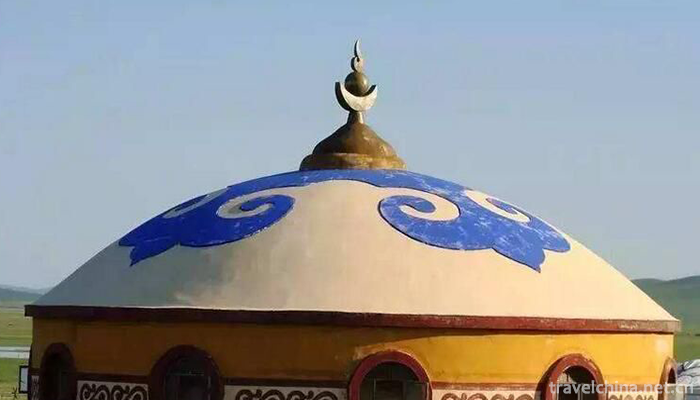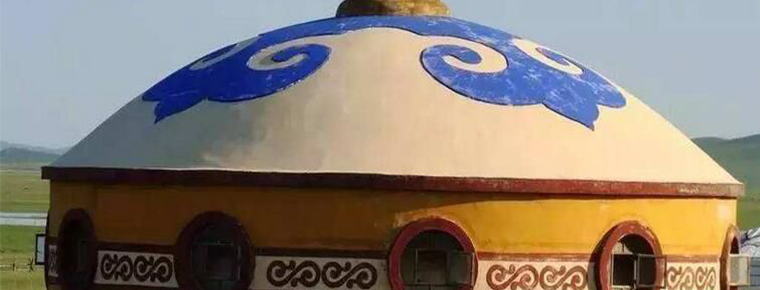Construction Skills of Felt House of Kazakh Nationality
Construction Skills of Felt House of Kazakh Nationality
Kazakh mattress building skills, Xinjiang Uygur Autonomous Region Tacheng area local traditional skills, one of the national intangible cultural heritage.
Kazakh mattress house is constructed by expandable wooden fence. It is surrounded by a circle of straw mats, which are woven with various colors of silk yarn and covered with white cloth embroidered blankets. The top of the carpet house is like a dome. The carpet covered can be opened upward so that the sunshine can be obtained in the tent.
In June 2008, Kazakh felt house construction technology was approved by the State Council of the People's Republic of China and listed in the second batch of national intangible cultural heritage list, heritage number: _-183.
historical origin
The construction of felt house of Kazakh nationality is an ancient craft, which has a history of more than 2,000 years.
In the Han Dynasty, the fine princess married to King Wusun sang in the song Yellow Crane: "My family married me to the heavenly side, far from the foreign King Wusun. The fornix serves as a wall, and the meat serves as a pulp. I wish to return to my native land for the Yellow Oriole because I think of my heart injury. This poem describes the felt room. The "dome" in the poem is the dome, which is the structural form of the felt house. It can be inferred that the princess Xijun described the felt room. This shows that in the period of Wusun Ancient Kingdom, the Kazakh people's ancestors have popularized the mobile architecture, and the construction technology has made a qualitative leap.
Process characteristics
Kazakh felt house construction techniques include carving, carving, chisel, weaving, tie, dyeing and other processes, the process is quite complex. The carpet builder made dyes and dyed colorful wool to weave curtains and roll felt, without any drawings and patterns, edge embroidery.
Kazakh mattress house is round in outline, simple in appearance but complicated in craftsmanship. All building materials and processes are completed by hand. It is not only convenient to carry, but also durable, comfortable to live, and has the characteristics of cold, rain and earthquake prevention.
Inheritance and protection
Inheritance value
Kazakh people's carpet building skills show their superb wisdom and infinite creativity, which indicates that Kazakh people's handicraft skills have reached a superb level, which condenses Kazakh people's aesthetic concept, humanistic thought, folk characteristics and historical memory, and has important reference value in the study of minority aesthetics, folklore and other fields.
Kazakh felt house occupies an important position in Chinese residential buildings. The mechanics and material methods involved, comprehensive dynamic plastic arts and technological ideas are of great research value.
Inheritance status
The emergence of industrialized production of cheap and beautiful carpets, embroidered carpets and portable steel tube houses has brought great impact on the traditional construction techniques of Kazakh carpet houses. The handicraft inheritors of this minority are on the older side, and are gradually decreasing. The handicraft inheritance of this minority has no worries about successors and needs to be protected urgently.
Inheriting characters
Dalekhan Habidihi, selected as the representative successor of the third batch of national intangible cultural heritage projects, declared in Tacheng area of Xinjiang Uygur Autonomous Region, declared the project: Kazakh mattress building skills.
protective measures
In 2013, Yerk, the inheritor of Kazakh carpet house construction technology, wanted to let the villagers around him make carpet houses with him, and form an industry of carpet house production. His Xinyuan County Saike National Handicraft Professional Cooperative was established. Through the form of joint venture, 57 villagers participated in the cooperative, and more than 20 felt houses were sold annually in the cooperative.
social influence
Important exhibition
In September 2016, at the Xinjiang International Convention and Exhibition Center, Kazakh felt room appeared in the textile exhibition hall of the Fifth China-Asia-Europe Expo.
In August 2016, Kazakh felt house appeared at the 4th Silk Road Xinjiang Cultural and Creative Industries Expo.


-
1.Hakka stuffed tofu
Hakka-brewed tofu, also known as minced meat-brewed tofu and Dongjiang-brewed tofu, is one of Hakka's famous dishes and is said to be related to...
Time 2018-11-02 -
2.West Lake Scenic Spot in Hangzhou
Hangzhou West Lake Scenic Spot is located in the center of Hangzhou City, Zhejiang Province. It is divided into lakeside area, Lake Center area
Time 2018-12-07 -
3.Three Lanes and Seven Alleys
Three Lanes and Seven Alleys(Sanfang Qixiang) is a national 5A tourist attraction, which is the only remaining part of the old city of Fuzhou
Time 2018-12-08 -
4.Hunan Provincial Museum
Hunan Museum is the largest museum of history and art in Hunan Province. It covers an area of 49,000 square meters and has a total floor area of 91,000 square meters.
Time 2019-01-16 -
5.Jiaying Scenic Spot
Jiayingguan, commonly known as the Longwang Temple of the Yellow River, is located in Jiayingguan Township, Wuzhong County, Jiaozuo City, Henan Province, China
Time 2019-01-21 -
6.Kuqa Wangfu Scenic Area
Located in Kuqa County, Xinjiang, the "Kuqa Wangfu" was built by Emperor Qianlong of Qing Dynasty in 1759 by dispatching Han craftsmen from the mainland in order to commend the local Uygur l
Time 2019-01-29 -
7.Sacrifice Aobao
Aobao sacrifice is a traditional custom of Mongolian people, and one of the manifestations of prairie people's natural worship. Xilinguole League is a relatively complete
Time 2019-05-05 -
8.Mongolian Long tune Folk Songs
Mongolian long-tune Mongolian is called "Uri Tudao", which means long song. It is characterized by fewer words, long-lasting, soothing and free, suitable for narration, and longer lyric.
Time 2019-06-04 -
9.Miao Drum and Tibetan Festival
Guzang Festival, also known as the Drum Festival, is a ceremony for the Miao tribe to sacrifice the gods of their ancestors, commonly known as "eating drums and hiding". Guzang Festival exis
Time 2019-06-05 -
10.Ningjin Acrobatics
Ningjin acrobatics is one of the traditional folk acrobatics in Shandong Province. With its long history of development, extensive mass base, profound cultural heritage and exquisite performing skills
Time 2019-06-08 -
11.Geographical environment of Luzhou
Luzhou City, located in the southeast of Sichuan Province, borders Chongqing and Guizhou Province in the East, Guizhou Province in the south, Yunnan Province, Yibin City and Zigong City in Sichuan Province in the west, Neijiang City and Chongqing City in Sichuan Province in the north.
Time 2020-12-14 -
12.Meishan landform
Meishan city is high in the West and low in the East, high in the South and low in the north. The territory of mountains and horizontal, hilly ups and downs, dense river network. The central part is the broad Minjiang River valley plain. Guangdongdong mountain in Hongya
Time 2020-12-18